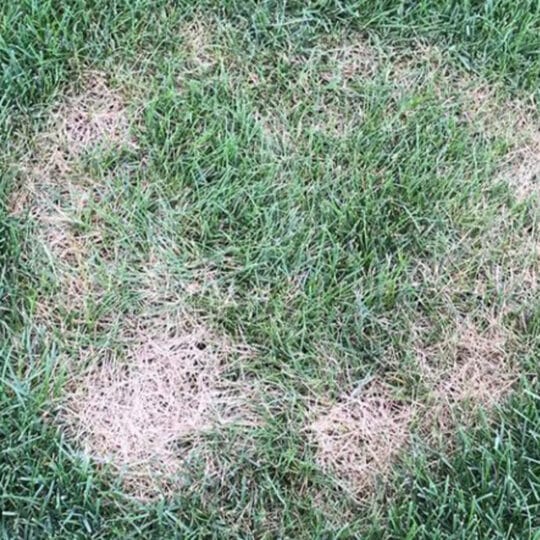6 Ways to Help Stressed Summer Grass
How to Tell if it’s Dead or Dormant

Ever walk outside and feel summer’s dry, oppressive heat suck the life out of you? That’s what your grass can feel like too. Between the extreme temperatures and drought conditions, grass that’s usually lush and green can turn brown and brittle. But this doesn’t necessarily mean it’s dead. Learn the signs of stressed summer grass and how to tell if it’s dead or dormant.
Factors of Stressed Summer Grass
Like many living things, grass thrives in moderate temperatures. While warm-season grass has a higher threshold for summer’s heat, there are other factors that can stress it out. Whether you have warm- or cool-season grass, it can go dormant in extreme temperatures.
On top of that, water quickly evaporates in the heat, sucking the moisture out of soil and grass blades. Couple this with insufficient rainfall and your grass is left extremely thirsty, especially if you’re under local drought restrictions that limit how much you can water.
Now, think about how much foot traffic your lawn gets this time of year. Between BBQs, sports, and extended play hours, your lawn can get trampled and the soil becomes compacted. This closes off the flow of air, water, and nutrients needed for grass roots to grow and thrive. Weakened roots makes the lawn even more susceptible to damage.
Signs of stressed grass includes:
- Wilt
- Brown spots
- Dry, brittle blades
While some spots of grass may look dead, it could also just be dormant. Grass goes dormant under extreme conditions—like the cold and heat of winter or summer—to try and conserve energy. Before you rush to find a lush grass remedy, take a moment to evaluate if the grass is dead or dormant.
Dead Versus Dormant Grass
Both dead and dormant grass have similar characteristics, such as a dry, brownish color, slow growth, and signs of thatch. However, there are more signs to consider to determine whether or not your grass will grow back or if you need to eventually reseed. If you try to fix the wrong issue, you could end up doing more damage to your yard.
Consider the following factors:
- The season. Grass goes dormant in the summer and the winter to conserve water and nutrients.
- The weather. Grass is stressed in high heat and freezing temperatures, so it goes into a dormant state to help protect itself and preserve energy.
- The type of grass you have. Cool-season grass is more likely to go dormant in the summer since it prefers the cooler temperatures.
So if it’s been a very hot, dry summer, chances are your brown grass is still very much alive. Even though it’s brown up top, the underground roots are storing energy to bounce back in better conditions. Here are some other ways you can tell the grass is more dormant than dead.
- It perks up after watering
- Sections don’t lift easily
- Roots are white
If your grass is dead, it won’t bounce back, even after a drenching rain, and sections will lift easily from the soil.
How to Help Grass Survive the Summer
If you’ve determined your grass is dormant, there’s less you need to do. Dormancy is a natural occurrence that can’t be prevented and doesn’t need to be treated. However, there are still ways you can help ensure your grass doesn’t eventually die.
- Proper watering. There are ways to over and underwater your lawn. Deep, infrequent watering is better for root growth than short, frequent sessions. You also want to water early in the day when it won’t evaporate quickly. Keep any drought restrictions in mind. Use a rain gauge to help calculate rainfall and adjust your watering schedule accordingly.
- Aerate. Help reduce soil compaction and improve air flow, drainage, and nutrient absorption.
- Mow. Determine the optimal height for the type of grass you have and only cut when needed. Remember, dormant grass doesn’t grow as fast so you don’t need to mow as much. Longer grass blades help to shade the soil and promote deeper root growth, so try not to cut your lawn too short and stress it even more. Leave the clippings to act as natural mulch and help retain moisture.
- Fertilize. When you use a slow-release fertilizer in the spring, it can help provide your lawn with nutrients when it needs it the most in the summer. Adding compost to your soil also helps it retain moisture and provide nutrients.
- Weed. Not only are these less desirable plants an eyesore, they compete with your grass for essentials.
- Pest control. Certain bugs thrive in this heat and are more than happy to feast on your grass roots.
It’s never too early or too late to get your grass in great shape. Contact Green Image Lawn Care to evaluate your yard and help determine how it should look this season. Our lawn care experts can put a maintenance plan in place so you can easily tell when it’s dormant and when it’s time to act. Then, if you need help restoring your grass back to its natural lushness, we’ll work throughout the fall and into the spring to strengthen grass roots to survive in any season.